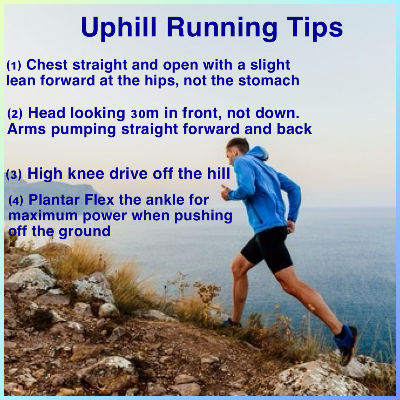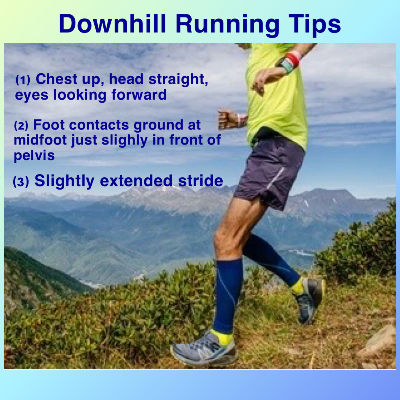RUNNING FORM ON HILLS
Running uphill and downhill require some slight tweaks to your form to maximize your power and efficiency as well as provide you much needed oxygen.
These recommendations are for running uphill and downhill on the road or on the trail.
Here are 4 form recommendations running uphill and 3 form recommendations running downhill, and how to perform them.
RUNNING UPHILL
1. One Of The Most Important Element Is To Keep Your Chest Up And Open.
Many runners focus to lean into the hill. Unfortunately, this causes many runners to hunch at the waist to lean forward. This compress your airway and makes it harder to breathe deeply.
You do need to lean forward, but make sure you lean at your hips, not your waist.
2. Keep Your Head And Eyes Up, Looking About 30 Meters In Front Of You.
Dropping your head restricts how much oxygen you can take in and will cause you to slouch.
Also, drive your arms straight forward and back.
Your arms should form a 90-degree angle at the elbow, and swing straight back and forth, not across your body.
3. Focus On Driving Your Knee Off The Hill, Not Into The Hill
Like you might do if you maintained your normal knee drive.
Work on landing on the ball of your foot to spring up the hill.
4. Plantar Flex (point your toes towards the ground) At The Ankle.
Think of yourself exploding off your ankle and using that last bit of power to propel you up the hill with minimal energy expenditure.
Focusing on plantar flexion can save you a lot of energy and really help you get up the hill faster and with less energy.

DOWNHILL RUNNING
Even though uphill running is the part that requires additional effort, having the correct downhill running technique will only help you, and can make a big difference to your performance. Running downhill has more impact.
1. Keep A Slight Forward Lean
Just like when running uphill, you want to have a slight lean forward at the hips to take advantage of the downhill.
Don’t overdo the lean, you only need a slight tilt to benefit from gravity.
Keep your arms relaxed and only slightly moving forward and back. Don’t move them to the sides, this will waste energy.
Also, keep your head up and your eyes looking forward.
2. Land With Your Foot Either Right Beneath Your Torso
Or just slightly in front of your pelvis, depending on the grade of the downhill (the steeper the grade, the more likely your foot is to land out in front).
Extending your leg too much will cause you to land on your heel, which will act like a breaking motion.
Focus on landing towards your midfoot to maintain speed while staying in control, and avoid injuries.
3. Stride Length Should Naturally Extend When Running Downhill.
However, you should not need to consciously increase your stride length.
The pace and the grade of the hill will do this naturally for you as you run downhill.

Focus On Good Running Form Uphill and Downhill, The Feet, Knees, Hips, Chest, And Arms, To Protect The Impact, Make It Feel Easier Up And Down Hill, Avoid Injuries, And Feel A Nice And Better Run!

Comments